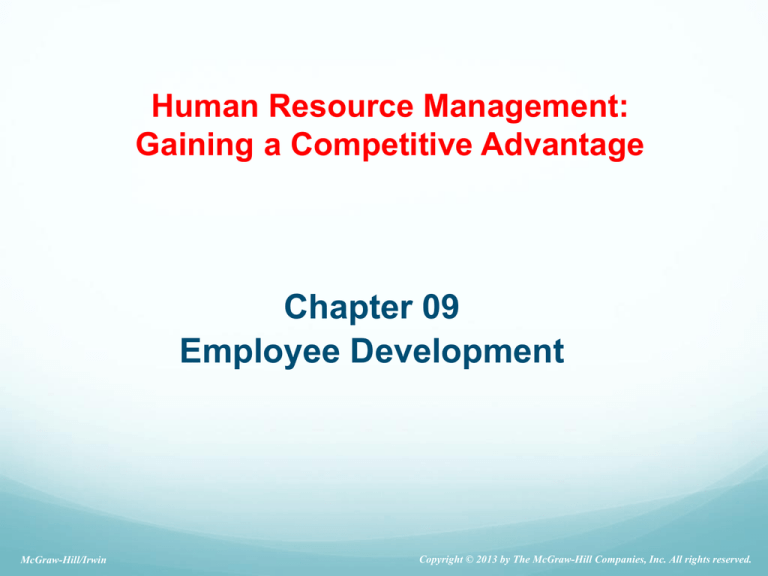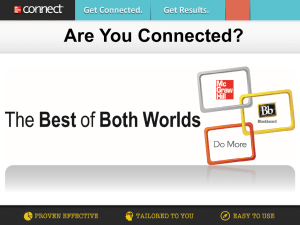
Human Resource Management:
Gaining a Competitive Advantage
Chapter 09
Employee Development
McGraw-Hill/Irwin
Copyright © 2013 by The McGraw-Hill Companies, Inc. All rights reserved.
Learning Objectives
Explain how employee development
contributes to employee retention, developing
intellectual capital and business growth
strategies.
Discuss current trends in using formal
education for development.
Relate how assessment of personality type,
work behaviors and job performance can be
used for employee development.
Explain how job experience can be used for
skill development.
9-2
Learning Objectives, cont.
Develop successful mentoring programs.
Describe how to train managers to coach
employees.
Discuss development planning process steps.
Explain employees’ and company’s
responsibilities in planning development.
Discuss what companies are doing for
management development issues including
succession planning, glass ceiling and
dysfunctional managers.
9-3
Training and Development Comparison
Training
Development
Focus
Current
Future
Use of work
experience
Low
High
Preparation for
Preparation for
current job
changes
Required
Voluntary
Goal
Participation
Development is defined as formal education, job experiences,
relationships, and assessment of personality and abilities that
helps employees prepare for the future
9-4
Careers
A protean career is based on self-direction with the
goal of psychological success in one’s work.
Psychological success - feeling of pride and
accomplishment that comes from achieving life goals.
Development Planning System- retain and motivate
employees by identifying and meeting development
needs. (also called career management system)
9-5
Steps and Responsibilities in the Career
Management Process
McGraw-Hill/Irwin
©2012 The McGraw-Hill Companies, All Rights Reserved
Sample Development Plan
McGraw-Hill/Irwin
©2012 The McGraw-Hill Companies, All Rights Reserved
McGraw-Hill/Irwin
©2012 The McGraw-Hill Companies, All Rights Reserved
Employee Development Approaches
Formal Education – ex. Executive MBA
Assessments – collect information and provide
feedback about behavior, communication style, skills
Personality Tests and inventories such as
Myers-Briggs (MBTI), etc.
Performance appraisals
Upward feedback
360-Degree Feedback Systems
Job Experiences
Interpersonal Relationships
9-9
Assessment Centers
An assessment center, usually off-site, uses
multiple raters to evaluate employees’
performance on exercises.
4 Types of Assessment Exercises:
1.
2.
3.
4.
Leaderless group discussion
Interviews
In-baskets
Role plays
9-10
McGraw-Hill/Irwin
©2012 The McGraw-Hill Companies, All Rights Reserved
Skills for Managerial Success
9-12
360-Degree Feedback Activities
Identify:
Strengths &
Weaknesses
Process for
recognizing goal
accomplishment
Development
Goal
Strategies for
reaching goals
9-13
Job Demands and Lessons Learned
Make
transitions
Create
change
Have high
level of
responsibility
Face
obstacles
Be involved in
non-authority
relationships
9-14
Job Experiences for Career Development
Vertical
Assignments
Lateral
Moves
9-15
Job Experiences
Job enlargement -adding challenges or new
responsibilities.
Job rotation-moving a single individual from one job to
another.
Transfer-moving an employee to a different job
assignment in a different area of the company.
Promotions-advancement into positions with greater
challenge and more authority than previous job.
A downward move occurs when an employee is given
a reduced level of responsibility and authority.
9-16
Temporary Assignments
Externship refers to a company allowing
employees to take a full-time operational
role at another company.
A sabbatical is a leave of absence from
the company to renew or develop skills.
9-17
Successful Mentoring Programs
9-18
Benefits of Mentoring Relationships
Career Support
Coach, protect, sponsor and provide challenging
assignments, exposure and visibility.
Psychological Support
Serve as a friend and role model, provide positive
regard and acceptance and create an outlet for a
protégé to share anxieties and fears.
Group Mentoring Program
A program pairing successful senior employees with
less experienced protégés.
9-19
Coaching
A coach is a peer or manager who works with an
employee to:
motivate
develop skills
provide reinforcement and feedback
3 roles a coach can play:
1. one-on-one
2. help employee learn
3. provide resources such as mentors,
courses or job experiences
9-20
Career Management Process
Identify
opportunities
to improve
Identify
needs
realistic to
develop
Identify
goals &
methods to
determine
progress
Identify
steps &
timetable
to reach
goals
9-21
Development Plan
C
o
m
pe
te
nc
ie
s/
str
en
gt
hs
C
ar
ee
r
N
de
ex
ve
t
lo
as
p
si
m
gn
en
m
t
en
go
ts
al
s
Competencies
&
Strengths
9-22
9-23
Summary
Development methods include formal education,
assessment, job experiences and interpersonal
relationships.
Both employee and company have responsibilities.
A mentor can help employees better understand the
company and gain exposure to key persons.
A manager’s job responsibility is coaching.
Employees should have a development plan.
9-24





